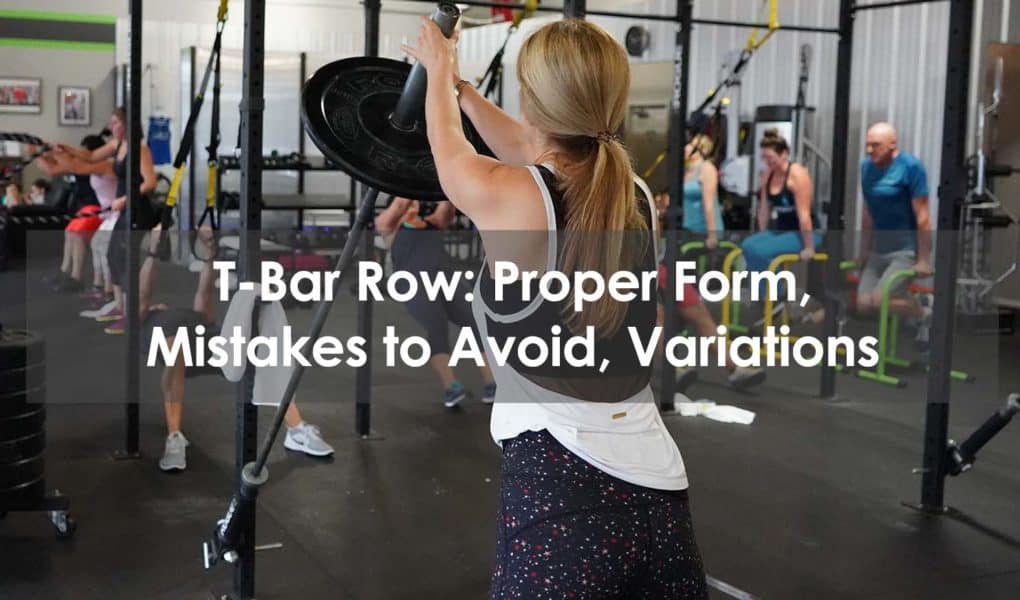The T-Bar Row exercise is a classic old-school bodybuilding exercise that is still extremely popular in gyms all over the globe. It’s a very good lat builder exercise that allows you to go hard and heavy to develop back thickness. Do it wrong, however, and you could do yourself a long-term injury.
In this article, I’ll cover the proper T-Bar Row form, along with 5 great T-Bar Row variations for those who are unable to do the exercise.
T-Bar Row Proper Form
Proper Form
- Place an empty barbell on the floor and load plates on one end. Weight down the other end of the bar by placing a 45 pound plate on top of it.
- Grab hold of a V grip handle and slip it under the bar just behind the loaded plates.
- Stand over the bar with your feet shoulder width apart, back arched, shoulder blades pulled back and your knees slight bent.
- Lift the bar slightly so that your upper body is at a 45 degree angle.
- From this starting positing, pull through the lats to bring the bar up to chest level.
- Lower under control to fully extend the lats without touching the bar to the floor.
Training Tips
Maintain a natural back arch throughout the entire t-bar row movement; contract your lats in the top position; fully stretch the lats in the bottom position; keep your abdominal muscles tight.
Common T-Bar Row Mistakes to Avoid
- Rounding the back – if you round your back as you pull the bar up, you place excessive strain on your spinal column. Be sure to maintain a neutral spine throughout the entire exercise.
- Standing too tall – if you are too upright, you will not be able to adequately engage your lats and the exercise will become an arm and shoulder movement. Make sure that you drop your hips low and angle your torso to 45 degrees.
- Putting too much weight on the bar – if you pack on more plates than you can handle, you will only force yourself to round your back and reduce your range of motion. Leave your ego at the gym door, and use a weight that will allow you to use proper exercise form.
T-Bar Row Alternatives
Some people are unable to perform the T-Bar Row exercise because they have ongoing lower back problems. For these people, there are a number of alternatives that will work the lats just as effectively.
The first and best alternative is the One Arm at Pull-In. This exercise is done seated side-on to a cable pulley machine. It allows you to work your lats unilaterally to provide greater individual strength and muscle potential. This is also the best lat exercise to simulate the full biomechanical range of motion of the latissimus dorsi.
The next best alternative is the deadlift. This is a compound exercise that allows you to lift a huge amount of weight. It is an effective move to thicken the lats as well as strengthening the spinal erectors. The deadlift is also one of the best things you can do to strengthen your hamstrings.
The third best T-Bar alternative is the sled push. This is a functional compound move with a strong cardiovascular aspect that directly engages the lats. Every inch of movement of the sled is powered by your latissimus dorsi muscles. Get nice and low on the sled push to maximally engage your upper back muscles.
T-Bar Row Variations
Chest Supported T-Bar Row Machine
Step by step how to:
- Load the weight plates on a chest supported T-Bar row machine.
- Lie on the 45 degree bench pad and reach down to grab the handles.
- Arch your back as you lift your chest and contract your lats.
- From this start position, pull the bar up to full contraction.
- Lower to full arm extension and repeat.
Training Tips:
Depress the shoulder blades in the tart position and contract the mid-back in the top position.
Incline Dumbbell Row
Step by step how to:
- Place a pair of dumbbells on the floor at the base of an incline bench.
- Set the bench at a 45 degree angle.
- Lie face down n the bench with your head and shoulders hanging over the edge and set you feet firmly on the floor.
- Reach down to grab the handles with an overhand grip and hang then down at arm’s length.
- From this start position, row both arms up to your chest muscles.
- Lower and repeat.
Training Tips:
Fully contract the target muscle in the top position.
Dumbbell Pendlay Row
Step by step how to:
- Stand with feet hip width apart and a pair of dumbbells held in your hands with an overhand grip at your sides.
- Hinge at the hips to bring your upper body down until it is parallel with the floor.
- Row the dumbbells up to your ribs, keeping your back parallel to the floor.
- Lower and repeat.
Training Tips:
Tense your major muscle of the back in the top position.
Band Back Shoulder Extension
Step by step how to
- Affix a resistance band to a secure upright at around waist level. Stand about five feet away from the upright facing it and grab the ends of the bands, holding them at arm’s length by your sides. Adjust your position so that the band is taut in the start position.
- With straight arms extend you’re your arms back and out. Contract your trapezius muscles in the full extension position.
- Lower and repeat.
- Do 3 sets of 15.
Equipment
Resistance band
Training Tips
Pull back with straight arms to full arm extension.
Final Thoughts
The T-Bar Row is one of the best exercises you can do to add thickness to your mid and upper back muscles. Be sure to perform the exercise with proper form, being sure to maintain a neutral back position, keeping your torso at a 45-degree angle, and not going too heavy.
If you are unable to do the standard T-Bar exercise, there are a number of variations and alternatives that better protect your lower back. Combine your back exercises into a workout routine of 3-4 exercises for a total of 12-14 sets. Varying your rep range from a high of 20 to a low of 6 reps with your heaviest weight.
Frequently Asked Questions
Which muscles are worked in the t-bar row exercise?
This exercise works the major back muscles; the latissimus dorsi, the rhomboids, the middle trapezius. There is also some activation of the front deltoids and biceps.
Is the t-bar row dangerous?
If you perform the exercise with proper form and don’t use more weight than you can handle, it is not dangerous. However, if you round your back as you pull up, you could cause damage to your spine.
Does t-bar row work hamstrings?
This exercise does not significantly work your hamstrings. The hamstrings are isometrically activated when you are in the rowing position but this will not build strength or muscle.







